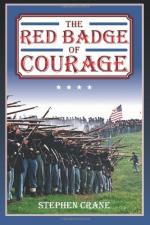|
This section contains 428 words (approx. 2 pages at 400 words per page) |

|
The Red Badge of Courage Summary & Study Guide Description
The Red Badge of Courage Summary & Study Guide includes comprehensive information and analysis to help you understand the book. This study guide contains the following sections:
This detailed literature summary also contains Bibliography and a Free Quiz on The Red Badge of Courage by Stephen Crane.
Stephen Crane's internationally acclaimed work, The Red Badge of Courage, was published in 1895. Unique in style and content, the novel explores the emotions of a young Civil War recruit named Henry Fleming. What is most remarkable about this classic is that the twenty-four-year-old author had never witnessed war in his life before writing this book. Crane's story developed to some degree out of his reading of war stories by Russian novelist Leo Tolstoy and the popular memoirs of Civil War veterans, yet he also deviated from these influences in his depiction of war's horror. Critics have noted that his portrait of war is an intensely psychological one, blending elements of naturalism, impressionism, and symbolism. Indeed, he broke away from his American realist contemporaries, including his mentor William Dean Howells, in his naturalistic treatment of man as an amoral creature in a deterministic world.
For this reason, critical reactions to the The Red Badge of Courage in 1895 were mixed: some disapproved of Crane's use of the vernacularthe common slang of everyday folk and soldiersand the impressionistic technique. Crane also experimented with psychological realism, and his venture into the realm of the human psyche radically changed the common perception of the novel in America. As he faces combat for the first time, Henry experiences an intense array of emotions: courage, anxiety, self-confidence, fear, and egotistic zeal. Interestingly enough, the naturalistic flavor of the work operates against this serf-important ego. The individual is not of primary importance, as is evidenced time and again in the words of Henry's mother, fellow soldiers, and officers. Henry is often referred to quite impersonally as "the youth." The men, untried and untested, are treated like scared animals against the backdrop of inimitable Nature and War. Crane also used color imagery, both vibrant and subtle, to describe war. He describes a skirmish as sounding like a "crimson roar," for example, and writes of war as "the red animal." Crane's sense of color pervades the work; note his description of the sky, which remains "fairy blue" during the day, as if to underscore the indifference of nature to the carnage taking place.
Neglected for two decades after his death, Crane's work was rediscovered in the 1920s by poets and novelists, such as Amy Lowell and Sherwood Anderson, who recognized in his experiments with new subjects, themes, and forms something of the spirit of their own literary aims. In the 1950s, critical essays focused on his religious themes. Today, Crane's novel is widely read and appreciated for its amalgamation of artistic themes and techniques.
Read more from the Study Guide
|
This section contains 428 words (approx. 2 pages at 400 words per page) |

|



